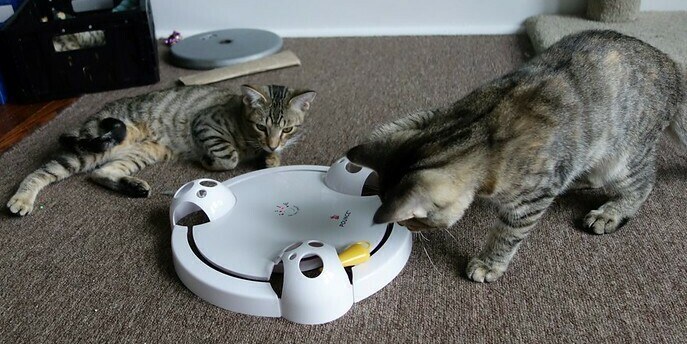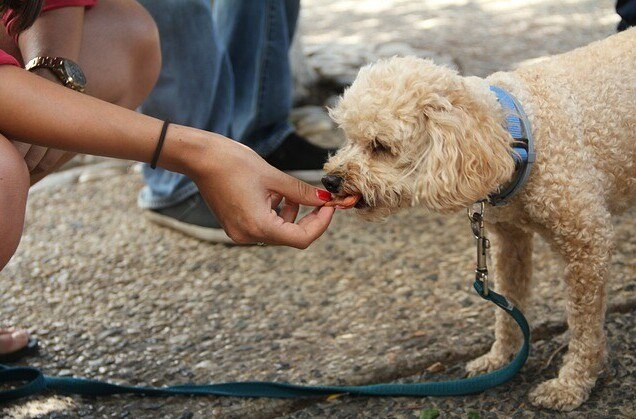If you’ve ever come home to find your furry friend in distress, pacing anxiously, or exhibiting destructive behaviour, you know the heartache of pet separation anxiety.
We understand that owners also experience separation anxiety from their pets, but in this article, we look at how it affects pets. Here, we will discuss expert ways to help your pet overcome this common obstacle.
From understanding the root causes to implementing positive reinforcement techniques, we’ll walk you through each step to ensure your pet feels secure and content even when you’re away. So, grab a treat (for you and your pet!), and let’s get started.

Understanding Pet Separation Anxiety
Understanding pet separation anxiety symptoms is necessary for finding remedies. Animal companions may experience various emotions when away from loved ones. Recognizing warning signals can help manage the issue and provide necessary support for pet survival.
What is Pet Separation Anxiety?

Pet separation anxiety, a psychological condition, can result from distress and worry when pets are separated from their owners. Although common with dogs, other pets like cats can also experience it.
Symptoms vary but can include excessive barking, whining, pacing, improper elimination, and destructive behaviour, often displayed shortly after the owner’s absence.
Recognizing Pet Separation Anxiety Symptoms in Your Pet
Identifying signs of pet separation anxiety is important for promptly supporting your pet. Note excessive vocalization, destructive chewing, pacing, and clinginess when you are getting ready to leave.
Pets may become overly attached, tremble, slobber, or pant excessively. Distinguish between separation anxiety and regular behaviour. Observing changes in pet behaviour can help identify potential issues early so you can proactively address them.
Common Triggers of Pet Separation Anxiety
Understanding the typical causes of pet separation anxiety can enable you to identify the underlying cause and modify your management strategy. Such causes include:
Change in Routine. Changes in daily routines, such as work hours, moving to a new home, or minor environmental changes, can trigger anxiety in pets.
Traumatic Events. Traumatic experiences like abandonment, natural disasters, or going to a shelter can cause pet separation anxiety, potentially leading to lifelong emotional scars and phobias of being alone.
Lack of Socialization. Inadequate socialization in early life can intensify separation anxiety in pets, as they may struggle to adjust to being left alone.
Previous Loss. When a pet loses a close friend, either a human or an animal, they may develop separation anxiety as a result of the trauma and grief associated with that loss.
Pre-existing Anxiety Disorders. Certain breeds, such as German Shepherds, Labrador Retrievers, and Cavalier King Charles Spaniels may be more prone to levels of high separation anxiety.
By recognizing these common triggers, you can take proactive steps to minimize their impact and create a more supportive environment for your pet.
Building a Strong Foundation
Pet separation anxiety can be effectively managed by creating a nurturing atmosphere that promotes emotional health and security. A strong foundation includes routine, gradual exposure, and comfort, laying the groundwork for long-term success.
Establishing a Routine for Pet Separation Anxiety
Establishing a consistent daily routine, including feeding times, walks, play sessions, and bedtime rituals, can help your pet feel secure and reduce separation anxiety.
Be calm. Maintain a calm, low-key demeanour when leaving and returning home to prevent pet anxiety; this establishes a predictable routine to remind them of the temporary nature of your departure.
Introduce departure cues: Using cues like picking up keys or putting on a coat can help desensitize your pet to these triggers and decrease their anxiety about your departure.
Incorporate interactive toys: Incorporate interactive toys or puzzle feeders into your pet’s routine. This will provide mental stimulation and keep them occupied during alone periods, reducing boredom and anxiety.
Maintaining a regular schedule gives your pet a sense of stability and predictability, which can ease pet separation anxiety and improve general well-being.
Gradual Introduction to Alone Time
Gradually increasing the duration of your pet’s separation anxiety exposure, starting with short, gradual periods, helps desensitize them to being alone and boosts their confidence.
Positive association with alone time. Offer treats or toys that your pet enjoys alone, as it helps them associate being alone with positive experiences, making it less daunting.
Leaving and returning. Repeat daily departures and returns to your pet to teach them that your absences are temporary, reducing anxiety and building trust.
Using a crate. Using a crate or safe space for your pet during your absence can provide them with a sense of security and prevent destructive behaviours linked to separation anxiety.
Introduce alone time gradually to your pet, allowing them to adjust and overcome separation anxiety with patience and persistence.
Creating a Comfortable Environment

Making sure your pet has a cozy space might help them feel far less anxious when left alone. Here are some suggestions:
Cozy bed or blanket. Place these in a quiet area of your home where your pet can retreat when they need some downtime.
Music or white noise. To reduce pet anxiety, consider playing soothing music or white noise in the background, with classical or pet-specific music being suggested as a potential solution.
Comfortable temperatures. Maintain a comfortable home temperature for your pet, especially when leaving them alone. Extreme temperatures can increase their discomfort and anxiety.
Mental stimulation. During your absence, offer your pet mental stimulation through toys, puzzle feeders, or interactive games to reduce boredom and anxiety.
Supplements. Ask a vet about pheromone diffusers or calming supplements for pets struggling with separation anxiety. They can create a relaxed environment and reduce stress levels.
You may reduce your pet’s anxiety and make sure they feel safe even when you’re not there by providing them with a cozy and secure environment.
Positive Reinforcement Techniques
In this section, we’ll look at practical strategies that focus on rewarding desired behaviours and building your pet’s confidence. By using the power of positive reinforcement, you’ll empower your pet to overcome separation anxiety and thrive in your absence.
Desensitization Training
Desensitization training is a gradual process that helps your pet become less reactive to triggers associated with separation anxiety.
Without really leaving, begin by exposing your pet to mild versions of the triggers, such as picking up your keys or putting on your coat.
Over time, gradually increase the intensity of the triggers while providing rewards and positive reinforcement for calm behaviour. This helps your pet learn to associate these triggers with positive experiences rather than anxiety.
Consistency and patience are essential during desensitization, as pets may take time to adjust. Gradually increase your pet’s comfort level and decrease sensitivity to separation triggers.
Interactive Toys and Puzzles

In periods of alone time, interactive toys and puzzles are great resources for keeping your pet mentally engaged and occupied. Find toys that can solve puzzles or dispense treats.
These toys offer a fun and rewarding activity for pets, reducing anxiety and boredom, and encouraging them to use their instincts and intelligence.
Regularly rotating pet toys and introducing new puzzles can keep them engaged and prevent boredom by providing fresh challenges.
Ensure pet interactive toys are suitable for their breed, size, and personal preferences. Including puzzles and games in their routine can provide an exciting environment, help with pet separation anxiety, and improve mental well-being.
Reward-Based Training Methods
Reward-based training techniques use positive reinforcement, such as playtime, food, or praise, to encourage desired behaviours in pets, helping to treat separation anxiety.
Identify positive behaviours. Encourage desired pet behaviours like calmness and engaging with toys when you leave. Reward them with praise and treats when they display these desired behaviours.
Consistency is key. This is essential in reward-based training, as rewarding your pet for exhibiting desired behaviour, even if it’s a small step, reinforces the behaviour and encourages it.
Avoid punishment. Avoid punishing pets for separation anxiety behaviours, as it can increase stress and worsen the problem. Focus on redirecting attention to appropriate behaviours and rewarding compliance.
By using reward-based training techniques consistently over time, you can help your pet form healthy associations with being alone and lessen their anxiety when separated from you.

Seeking Professional Help
While pet owners can treat pet separation anxiety at home, in severe cases expert help may be needed. Following veterinarian advice or consulting certified animal behaviourists can significantly impact your pet’s health and help them overcome anxiety related to being alone.
Consulting with a Veterinarian
Visit your veterinarian to address pet separation anxiety and rule out medical issues. They will perform a comprehensive checkup, suggest diagnostic tests, and provide advice on the best course of action for your pet’s specific needs.
Veterinarians can prescribe drugs or supplements for pets with severe separation anxiety, reducing symptoms and easing behaviour modification. They can also suggest calming products and recommend certified animal behaviourists for treatment.
By consulting with your veterinarian, you can ensure that your pet receives the thorough care and encouragement they need to overcome separation anxiety and lead a happier, healthier life.
Working with a Certified Animal Behaviorist
If your pet’s separation anxiety persists despite veterinary intervention, consider consulting a certified animal behaviourist. They can provide personalized support and guidance for your pet’s specific needs.
A certified animal behaviourist will assess your pet’s environment and behaviour to identify underlying causes of separation anxiety. They will create a personalized plan, including training, environment adjustments, desensitization, and counterconditioning.
Certified animal behaviourists are experts in animal behaviour and psychology. They can help pets overcome behavioural issues like separation anxiety, enhancing their quality of life and success.
Lifestyle Adjustments and Additional Support
Making lifestyle changes and seeking extra support can be extremely important in helping your pet overcome separation anxiety, along with at-home techniques and expert aid.
This section discusses lifestyle modifications and resources for pet well-being. It includes exercise, mental stimulation, alternative therapies, and supportive communities, to effectively manage separation anxiety.

Exercise and Mental Stimulation
Regular exercise and mental stimulation are necessary for managing pet separation anxiety, as they help burn excess energy, reduce stress, keep the mind engaged and prevent boredom.
Exercise. Maintain your pet’s physical fitness by engaging in daily exercise routines like walks, runs, or play sessions, aiming for at least 30 minutes of moderate to vigorous activity daily.
Mental stimulation. To keep your pet mentally stimulated, incorporate puzzle toys, interactive games, and training exercises into their daily routine to enhance their problem-solving and mental abilities.
Obedience and training classes. Obedience lessons or training programs provide mental stimulation and improved behaviour. This allows them to socialize, lower anxiety, and boost self-esteem.
Prioritizing mental and physical stimulation and exercise in your pet’s daily routine can promote their overall wellbeing, and reduce separation anxiety.
Alternative Therapies and Supplements
Supplements and complementary therapies, such as massage therapy, acupuncture, and aromatherapy, can help pets manage separation anxiety and stress, in addition to standard treatments.
Certain supplements such as CBD oils and calming pheromone products may help alleviate pet anxiety symptoms. However, it’s important to see a veterinarian before adding any new supplements to your pet’s daily regimen.
Herbal remedies, such as chamomile or valerian root, are sometimes used to help calm anxious pets. While some pets may benefit from these natural remedies, others may not respond as effectively, so it’s essential to monitor your pet’s response and consult with your veterinarian for guidance.
Behavioural supplements like calming collars or vests can help pets with separation anxiety by promoting relaxation and reducing stress levels. These products contain certain pheromones or natural ingredients.
Consult your veterinarian before trying alternative therapies or supplements for pet separation anxiety. They can provide safe and appropriate solutions based on your pet’s specific circumstances.
Support Groups and Online Communities
Pet owners struggling with separation anxiety can find great emotional support and helpful guidance through support groups and internet communities.
You can find support groups and communities on social media platforms, forums, and websites dedicated to pet ownership and behaviour.
These groups provide connections, resources, and expert advice on pet behavior and training, enabling them to provide the best possible care and establish connections with others dealing with similar issues.
Conclusion
Treating pet separation anxiety requires multiple strategies that include patience, tolerance, understanding, and preventative measures. To help your pet overcome separation anxiety, identify signs, use positive reinforcement, and seek professional help.
Prioritize consistency, routine, and environmental enrichment. Also, making lifestyle changes like exercise and mental stimulation helps reduce pet separation anxiety and promote well-being.
Consult your veterinarian or certified animal behaviourist for personalized advice. These are experts in their field and are there to help you.
Don’t underestimate the value of support groups and online communities to offer encouragement and direction. With patience and support, you can create a stronger, lifetime bond with your pet. They need you!
This video reinforces what we have just discussed.

We love to travel. For our trip to Mexico, we were able to save money by house sitting, which was something completely new to us. If this is something that interests you, then check out TrustedHousesitters or HouseSitMexico (be sure and use Code thetr6210d47b7cc90 for discount). We hope you visit often.